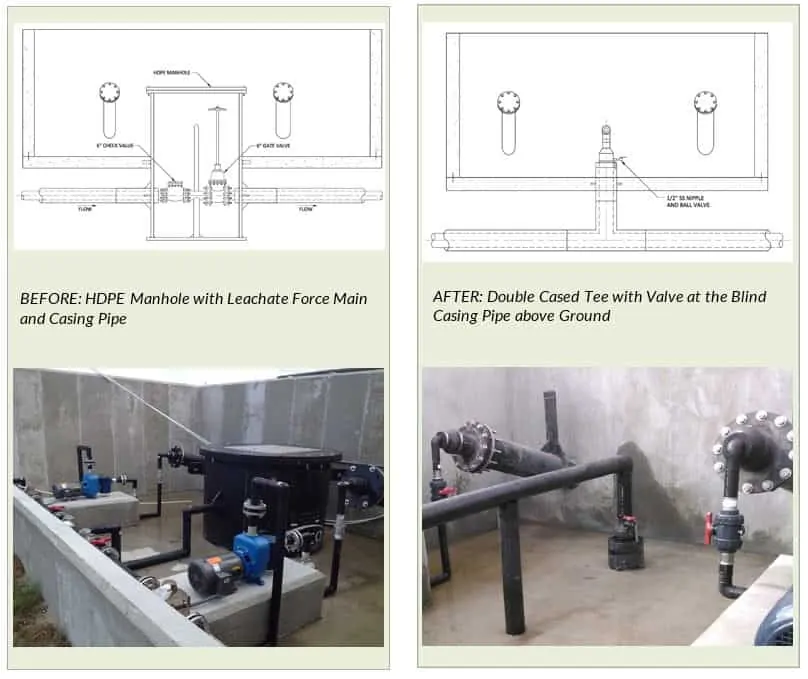

Introduction
PFAS are a class of synthetic fluorinated chemicals used in many industrial and consumer products, including defense‐related applications. They are persistent, found at low levels in the environment, and bio‐accumulate. Studies have shown these compounds being detected more often in surface water, sediments and/or bioaccumulated into fish tissue. Because of the greater affinity of longer chain per‐ and polyfluoroalkyl substances (PFASs) compounds for fish than other environmental matrices, certain compounds are often found in fish tissue, but not in the water or sediment. Table 1 shows average concentrations of PFOA and PFOS in landfill leachates around the world. The USEPA health advisory level is 70 ppt for PFOA and PFOS.
Table 1. Concentrations of PFAS compounds in Landfill Leachate around the world
| Compound | US | Germany | China |
| PFOA (ppt) | 660 | 150 | 280-214,000 |
| PFOS (ppt) | 110 | 30 | 1,100-6,000 |
Treatment Options for PFOS and PFOA
The removal of PFASs from drinking water has been the USEPA’s national priority. Recent discoveries of PFAS/PFOS in drinking water in multiple states in the US has heightened interest in these emerging contaminants. Federal, state, and local agencies are formulating regulatory limits that vary greatly. These limits seem to be centered on drinking water, but these developments are driving disposal of existing stores of chemicals containing PFAS/PFOS and environmental media contaminated with PFAS/PFOS
Treatment processes that can remove PFAS chemicals from drinking water may include high-pressure membrane systems such as RO, granular activated carbon (GAC), or ion exchange as shown in Figure 1. The more conventional water treatment technologies such as (e.g., aeration) are not typically effective.
Figure 1. PFAS Removal Processes (a) Membranes, (b) GAC and (c) Ion Exchange Resins
Landfill Leachate RO Treatment Plant – New Hanover County, North Carolina
New Hanover County upgraded its leachate treatment system to meet stricter regulatory standards for surface water discharges, particularly standards relating to metals (arsenic) and ammonia. Sampling by NC DEQ showed the new RO plant is filtering out PFAS. Table 2 shows the results from February 2019.
Figure 2. New Hanover County Leachate and PFAS Treatment Plant
Table 2. Concentrations of PFAS compounds in Leachate at New Hanover County Landfill
| PFAS Constituent | Raw | Treated | Surface water |
| PFOA (ppt) | 1,250 | < 0.6 | 3.9 |
| PFOS (ppt) | 228 | < 0.6 | 7.1 |
Comparison of GAC Types for PFOA and PFOS Removal
Four different types of GAC, i.e., Re-agglomerated Bituminous, Lignite, Enhanced Coconut and Enhanced Coconut (Blend) were evaluated under identical operating conditions and influent water quality. Figure 4 shows results from these four GAC products for PFOA/PFOS removal vs time.
Figure 4. GAC Treatability study for removal of PFOA and PFOS
Re-agglomerated bituminous coal GAC (FILTRASORB) significantly outperformed: Lignite, Enhanced Coconut and Enhanced Coconut (Blend).
Summary:
PFAS compounds are of concern because they do not break down in the environment, bioaccumulate in humans and biota, and may pose risks to human health
GAC, Synthetic adsorbent, and ion exchange resins are widely used for PFAS removal. Capacity and leakage of PFASs into the treated water varies depending on the specific PFASs, the type of adsorbent used.
PFAS removal may be influenced by pH, water temperature, contact time, Natural Organic Matter, and chlorine. For complete PFAS removal, a polishing may be required.
Disposal methods for PFAS waste streams include high-temperature incineration or landfilling. Landfilling is not favored since the PFAS load would increase, and many landfills will not accept PFAS waste.

According to Sean Bothwell, the executive director of the California Coastkeeper Alliance, “There are … thousands of facilities that have failed to enroll in the industrial stormwater permit, creating an economic disadvantage for those facilities that are doing their job to be compliant with their permit. SB-205 will level the playing field for the regulated community and help California achieve their mission of attaining swimmable, fishable, and drinkable California waters.”
California’s Stormwater Multiple Application and Report Tracking System (SMARTs) currently shows approximately 13,000+ active industrial stormwater sites/dischargers (Notice of Intent and No Exposure Sites). For these current General Stormwater Permit (IGP) enrollee’s vs. non-filers, the playing field has not been level across industrial sectors. There is a cost, sometimes substantial, for being in, and maintaining compliance under the IGP. The Permit is fee-based; water quality regulatory programs and the programs and resources supporting those programs are funded directly with the fees collected by these regulated entities under those programs.
The additional late-permittees and associated fees will help with the challenge of staffing at the State and Regional Boards, for processing and enforcement. As of today, there is not a direct additional fee/fine for the potential late filers; the message being that potential dischargers (or SIC code-based Facilities with a condition of No Exposure) not covered under the IGP should enroll as soon as possible, to avoid potential initial fines and future costly penalties.
Future penalties could also include “de facto” regulatory compliance penalties through non-government organizations (NGOs) and environmental group citizen lawsuits and 60-day notice-of-intents under Section 505 of the Clean Water Act. SCS Engineers advises businesses to check the Regional Board to see if they need coverage.
If unsure or unfamiliar with stormwater compliance, seek help from a Qualified Industrial Stormwater Practioner (QISP) or begin by using the resources linked to helpful sites from our blog. Although not a comprehensive list, these types of facilities do need stormwater compliance, as follows:

About the Author: Jonathan Meronek is a State of California Industrial General Permit (IGP) Qualified Industrial Storm Water Practitioner (QISP), QISP Trainer-of-Record (QISP-ToR) and an Envision Sustainability Professional (ENV-SP). With an eye to clients’ operational needs combined with long-term sustainable solutions, Jonathan has performed Site BMP and Pollutant Source Assessments, written Stormwater Pollution Prevention Plans (SWPPPs), and implemented Monitoring Implementation Plans (MIPs); for over one-hundred facilities throughout California.
He continues to provide National Pollutant Discharge Elimination System (NPDES) stormwater services for state, municipal, and private clients across a vast cross-section of industrial sectors. Jonathan works with LRPs, facility managers, and attorneys to re-evaluate facilities comprehensively for NPDES compliance using technology-based BPT/BCT/BAT/NSPS levels of control to reduce and eliminate pollutants of concern in stormwater discharge.
Landfill operators may add a casing pipe to their leachate force main for additional environmental protection. Consequently, the leachate force main is entirely located inside a casing pipe where the leachate force main is below ground. In the event of a leak from the leachate force main, liquids stay inside the casing pipe preventing leakage into the ground. During monitoring, checking for the presence of leachate inside of the casing pipes is routine.
For many years, I designed the installation of an HDPE monitoring manhole at each leachate removal sump station. Designed at the top of the perimeter berm, where the leachate force main is normally located, these manholes normally remain dry. The leachate force main crosses through the manhole without discharging into it. The casing pipes connecting to the manholes are open-ended at the manhole, draining directly into it. Easy to monitor, if liquids are present, you probably have a leak.
Using field operations experience, we improved the design.

A blind casing pipe above the surface leaves the leachate line exposed for piping purposes. In this design, the casing pipe does not connect to any vessel for monitoring; instead, it has a pressure gauge or small valve on it for pressure monitoring.
If the gauge reads pressure in the casing pipe, it is indicating there is liquid inside the casing pipe; leachate is leaking from the force main and filling the casing pipe causing the pressure to build. If using a valve, monitoring is opening the valve to look for liquid coming out of the casing pipe. Regularly monitored pressure gauges or valves is a standard operating procedure and easily accomplished.



About Wendell Minshew: Wendell is a Senior Project Manager in our Sacramento office. He has over 30 years of engineering experience. He specializes in civil engineering services in the planning, design, permitting, and construction management of solid and hazardous waste facilities. He is a licensed Professional Engineer in California and Nevada.
And an amazing photographer!
Per- and poly-fluoroalkyl substances (PFAS) are receiving increasing attention from regulators and the media. Within this large group of compounds, much of the focus has been on two long-chain compounds that are non-biodegradable in the environment: PFOS (perfluorooctane sulfonate) and PFOA (perfluorooctanoic acid). Long detected in most people’s bodies, research now shows how “forever chemicals” like PFAS accumulate and can take years to leave. They persist even when excreted through urine. Scientists have even tracked them in biosolids and leafy greens like kale. Recent studies have linked widely used PFAS, including the varieties called PFOA and PFOS, to reduced immune response and cancer. PFAS have been used in coatings for textiles, paper products, cookware, to create some firefighting foams and in many other applications.
Testing of large public water systems across the country in 2013 through 2015 found PFAS detected in approximately 4 percent of the water systems, with concentrations above the USEPA drinking water health advisory level (70 parts per trillion) in approximately 1 percent (from ITRC Fact Sheet.) Sources of higher concentrations have included industrial sites and locations were aqueous film-forming foam (AFFF) containing PFAS has been repeatedly used for fire fighting or training.
Source identification is more difficult for more widespread low-level PFAS levels. For example, in Madison, Wisconsin, PFAS have been detected in 14 of 23 municipal water supply wells, but the detected concentrations were below the USEPA’s health advisory levels for PFOA and PFOS. A study of potential PFAS sources near two of the Madison wells identified factories, fire stations, landfills, and sludge from sewage treatment plants as possible sources, but did not identify a specific source.
With the EPA positioned to take serious action on PFAS in late 2019 and 2020, regulators in many states have already started to implement their own measures, while state and federal courts are beginning to address legal issues surrounding this emerging contaminant. State actions have resulted in a variety of state groundwater standards for specific PFAS compounds, including some that are significantly lower than the USEPA advisory levels. These changes mean new potential liabilities and consequences for organizations that manufacture, use, or sell PFAS or PFAS-containing products, and also for the current owners of properties affected by historic PFAS use.
Questions for manufacturers, property owners, and property purchasers include:
If remediation is required, a number of established options to remove PFAS from contaminated soil and groundwater are available, including activated carbon, ion exchange or high-pressure membrane systems. On-site treatment options, including the management of reject streams where applicable, are also available.
Do You Need Help?
Need assistance with PFAS or have an idea that you would like to discuss? Contact for more information.
Use these resources to explore more about PFAS each is linked to helpful articles and information.
SCS Engineers welcomes Mark Pearson, P.E, to the firm’s environmental engineering practice. As a Project Director, he and his team will provide water and wastewater engineering and consulting to public and private entities in the region and the U.S. from SCS’s Overland Park office.
Mark brings decades of expertise in environmental engineering, with an emphasis on wastewater design for water treatment plants, wells, pumping stations, and including sewers and waterlines. His experience includes project management through facility planning, design, and construction phases; a good fit for SCS’s comprehensive solutions.
A Professional Engineer licensed in three states, he supports clients with the design, construction, and implementation of environmental treatment systems for water and wastewater plants and post-industrial use, reuse, and the disposal of liquids. Mark helps support industries and landfills facing increasing regulatory policies, higher standards required by water treatment plants, and the rising costs associated with protecting water supplies.
Mark has worked on a wide range of projects around the world and in the United States. He is a certified Envision Sustainability Professional (ENV SP) and a member of the National Council of Examiners for Engineering and Surveying (NCEES). He earned his bachelor’s degree in civil engineering from the Missouri University of Science and Technology, and his master’s degree in environmental engineering from California State University-Long Beach.
“Mark’s expertise and knowledge enhance SCS’s ability to provide sustainable process treatment design and wastewater solutions to industrial and landfill clients who are responsible for leachate and liquids management, which is a significant operational expense for them,” stated Nathan Hamm, a Vice President of SCS Engineers and Central region lead in the Liquids Management program.
Bill Lape discusses the most frequently asked questions about designing a training program that is part of your facility’s PSM and RMP programs and provides a defensible position during inspections while ensuring that your facility operators and maintainers perform their jobs safely.
Bill tackles all your questions in this article. Set-PSM-RMP-Hut-Hut
Comments were submitted to the EPA from NWRA/ SWANA regarding the EPA’s Advance Notice of Public Rule Making (ANPRM) for revisions to Subtitle D, and in particular potential revisions regarding the bulk liquids addition. Subtitle D prohibits bulk liquids additions with the exception of leachate recirculation, and the RD&D permit process allows bulk liquids. Bob Gardner of SCS Engineers was involved in the development of the joint NWRA/SWANA comment letter.
EPA has indicated that they are considering adding a “wet landfill” definition to Subtitle D; however, the Industry strongly advised against doing so. The letter addresses this issue and the reasons for recommending against a separate “wet landfill” definition.
Industry Association’s Comments
Wendell, a Senior Project Professional in the SCS Engineers Sacramento office became interested in photography 35 years ago. He had broken his ankle and needed something to do because he felt grumpy not being able to play tennis. His tennis partner loaned him a camera, some film, and his dark room.
Wendell was hooked.
Wendell’s beautiful photos capture the reason we work with our clients to protect our environment. See a few pieces of his organic work, and look for more soon.
Mr. Minshew has over 30 years of engineering experience. He specializes in civil engineering services in the planning, design, permitting, and construction management of solid and hazardous waste facilities. He is a licensed Professional Engineer in California and Nevada.
Thank you for sharing, Wendell.
For many oil and gas waste processing and disposal facilities, and water midstream facilities, groundwater monitoring is mandatory. The ongoing quarterly monitoring well sampling is a long-term operating expense that presents opportunities for cost reduction by employing new sampling technologies that reduce labor time and cost.
Conventional monitoring well sampling traditionally requires bulky and expensive pumps and support equipment. Time-consuming to use, these also require specialized training and are prone to mechanical failure in oil basin extreme weather conditions. Straightforward, lower-tech methods are available that can substantially lower field costs; in some cases, by up to 50 percent.
Best Practices
If your sampling results indicate potential problems, we recommend bringing in groundwater analytic expertise; this is where you want to concentrate your environmental compliance resources.
It is essential to conduct one or more background sampling events before a facility opening to interpret sampling results that may reveal facility issues. At SCS, we’ve seen many documented cases of facilities that unknowingly were operating over groundwater already contaminated by other nearby facilities or tainted by naturally occurring petroleum in the subsurface.
Another cost-reduction best practice is the application of statistical analysis to the lab results. While not always required by regulators, there are well-proven analytical tools that can answer questions about the source of apparent anomalies in the data. Ongoing application of these tools—even if only done internally—can reveal problems early and solve others before they become a liability.
O&G Environmental Services and Permitting
Jim Lawrence, SCS Engineers professional hydrogeologistAbout the Author: James Lawrence of SCS Engineers is a hydrogeologist with 25 years of experience in all aspects of the distribution and movement of groundwater in the southwestern and central portions of the U.S. Jim leads the groundwater monitoring program for SCS in the Permian Basin area. He works to resolve problems that arise with groundwater monitoring, including assessment monitoring, corrective action, landfill and natural gases, and alternate source demonstration issues.
His responsibilities include supervising the sampling, data reporting, and statistical analysis. His job experience includes extensive permitting-related hydrogeological characterizations, the design and implementation of groundwater monitoring systems, assessing groundwater geochemistry, soil and groundwater assessment investigations, risk reduction rules, groundwater modeling, design and implementation of numerous large dewatering systems, design of water supply wells, managing waste injection wells, managing CERCLA and RCRA investigations, and waste analysis/characterization programs.